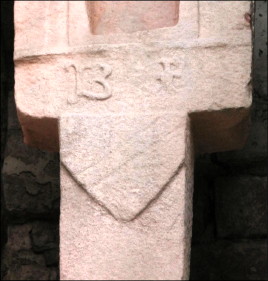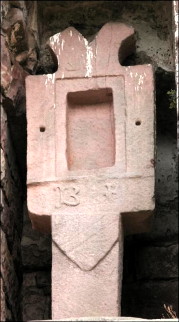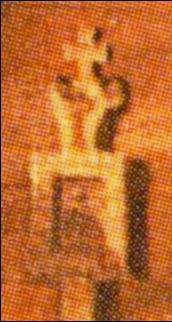Ancient family relic possibly located.
Last August I mentioned in a caption under the photo of Greystoke castle that Adam de Blencow's headstone was in a niche in the castle. This drew a response in the November newsletter as neither Peter nor Mr Neville Howard, the castle owner, knew anything of it. I was quite disappointed as it was something I seemed to "just know" yet I couldn't find a source for the information.
Recently, when researching the article on pages 7 and 8, I found the following:
Adam died about 1386-8 and was buried in an ancient cemetery near the great hall of Greystoke Castle. This was marked with a stone cross with the arms of the Blencowes. This cross now fills a niche in the exterior of one of the angles of the Castle.
I excitedly passed this information onto Peter who in turn contacted Mr Howard drawing the following response.
'This is an explanation of a stone whose genesis has been shrouded in mystery. The stone, badly weathered, was said to have been found on the Blencow road during the last war by some Polish prisoners of war who were based at the castle and provided much needed labour on local farms. Nobody quite knew what it was and my father, to preserve it, had it placed in the sealed end to a passage which runs through the thickness of the wall of the south tower. It is still there.'
If it is Adam's burial marker (or another early Blencowe), it is a hugely significant find. It is a family relic that predates Blencow Hall and possibly even the pile of stones that is the old hall.
I forwarded a detailed part of the painting which I thought was possibly what we were looking for and the photo came back with the message:
'There is a badly weathered date below the arms which begins 13.. . In what remains of the arms, the 'bend sinister' (which also occurs in the Howard arms) stands out clearly, which is the main reason for my assumption that the stone was in some way connected with my Howard family.
Among local families, the only arms to bear a 'bend sinister' were the Howard arms. However, the Howards did not reach Cumberland until the early 1500s, some 200 years after the date on the stone. To me, the telling part is the two broken pieces that would be the bottom of our crest. Their shapes in the remains of the marker are very similar to the painting given that we don't know how accurate the artist was on such an insignificant part of the picture. The 'bend sinister', which in common language is, a diagonal band running from the opposite top corner of a shield than a regular "bend",is a point of conjecture.

Bend Sinister
the faint parallel lines crossing the shield


Is this the artist's representation of the same crest?
Mr Howard further comments:
'The device on the top of the stone has always puzzled me. I have long believed that the two components must have been part of something more elaborate. In many such cases, the principle part of the device is in the centre with the parts on the side acting as supporters. Without knowing what the missing centre-piece could have been, it was difficult to make any judgement about the remaining 'wings'. I agree completely that the Blencow crest would fit the bill nicely. Another feature of the stone is the holes drilled into the sandstone around the cavity. These suggest that a metal grill of some sort had been fitted, presumably to protect from theft what was contained in the cavity. This led me to believe that the stone may have been a wayside shrine of some sort. But all this is mere guesswork'
I wonder if our shield once covered the cavity. The painting shows an object in the cavity. Have you any idea what it could be? By 1710 when it was painted Adam had been dead for 372 years.
Could it be that the stone was later adapted to a different use, possibly because its original use had been overtaken by change?
I wish to thank Mr Neville Howard for his research and interest in this matter which is of great importance to our family. What I have quoted are only snippets from his lengthy correspondences.
I do not have the background knowledge to further comment but I feel that some of our members will. Please, if you know anything further, have in your possession an early picture or description of the burial marker that once stood on the burial mound before being relocated to Blencow Hall, get in touch with Peter hopefully before the reunion.
Considering that Greystoke castle is not open to the public, our tour on Monday 28 July has now taken on monumental significance and is an event not to be missed.
Anne